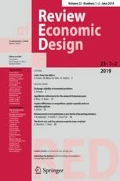Abstract
Sellers with one unit of land each are located at the nodes of a graph. Two sellers are contiguous if they are connected by an edge in the graph. The buyer realizes a positive value only if he can purchase plots that constitute a path of given length. We characterize the optimal mechanism when the buyer and sellers have independently distributed private valuations.


Similar content being viewed by others
Code availability
All numerical calculations are done by the author using GNU Octave, an open source high-level language.
Notes
Thanks to one of the anonymous referees for pointing this out.
This can be relaxed to any set of k connected notes on the graph. See Remark 8.
See Sarkar (2017) for a complete specification of the VCG mechanism for the land acquisition problem.
See Sarkar (2018), p. 43, Appendix B.1 for details.
Sarkar (2018) uses a strict inequality.
References
Cai H (2000) Delay in multilateral bargaining under complete information. J Econ Theory 93:260–276
Cai H (2003) Inefficient markov perfect equilibria in multilateral bargaining. Econ Theory 22:583–606
Chakravorty S (2013) The price of land: acquisition, conflict, consequence. Oxford University Press, New Delhi
Cournot AA (1838) Recherches sur les principes mathématiques de la théorie des richesses, L. Hachette
Cripps MW, Swinkels JM (2006) Efficiency of large double auctions. Econometrica 74:47–92
Fudenberg D, Mobius M, Szeidl A (2007) Existence of equilibrium in large double auctions. J Econ Theory 133:550–567
Gresik TA, Satterthwaite MA (1989) The rate at which a simple market converges to efficiency as the number of traders increase: an asymptotic result for optimal trading mechanism. J Econ Theory 48:304–332
Grossman Z, Pincus J, Shapiro P, Yengin D (2019) Second-best mechanisms for land assembly and hold-out problems. J Public Econ 175:1–16
Holmstrom B, Myerson RB (1983) Efficient and durable decision rules with incomplete information. Econometrica 51:1799–1819
Jackson MO (2000) Mechanism theory. The encyclopedia of life support system
Kominers SD, Weyl EG (2011) Concordance among holdouts. In: Proceedings of the 12th ACM conference on Electronic commerce, ACM, pp 219–220
Krishna V (2002) Auction Theory. Academic Press, Cambridge
McAfee RP (1992) A dominant strategy double auction. J Econ Theory 56:434–450
Menezes F, Pitchford R (2004) A model of seller holdout. Econ Theory 24:231–253
Miceli TJ (2011) The economic theory of eminent domain: private property, public use. Cambridge University Press, Cambridge
Myerson R, Satterthwaite M (1983) Efficient mechanisms for bilateral trading. J Econ Theory 29:265–281
Plassmann F, Tideman T (2010) Providing incentives for efficient land assembly, Tech. rep., working paper
Roy Chowdhury P, Sengupta K (2012) Transparency, complementarity and holdout. Games Econ Behav 75:598–612
Rustichini A, Satterthwaite MA, Williams SR (1994) Convergence to efficiency in a simple market with incomplete information. Econometrica 62:1041–63
Sarkar S (2017) Mechanism design for land acquisition. Int J Game Theory 46:783–812
Sarkar S (2018) Convergence of VCG mechanism to ex-post budget balance in a model of land acquisition. Math Soc Sci 93:37–46
Satterthwaite MA, Williams SR (1989a) Bilateral trade with the sealed bid \(k\)-double auction: existence and efficiency. J Econ Theory 48:107–133
Satterthwaite MA, Williams SR (1989b) The Rate of Convergence to Efficiency in the Buyer’s Bid Double Auction as the Market Becomes Large. Rev Econ Stud 56:477–498
Satterthwaite MA, Williams SR (2002) The optimality of a simple market mechanism. Econometrica 70:1841–1863
Williams SR (1991) Existence and convergence of equilibria in the buyer’s bid double auction. Rev Econ Stud 58:351–374
Xiao J (2018) Bargaining orders in a multi-person bargaining game. Games Econ Behav 107:364–379
Funding
Part of the manuscript was written when the author was receiving a fellowship from Indian Statistical Institute. A travel grant from the author’s employer to present this paper at the 14th Annual Meeting of the Society for Social Choice and Welfare, Seoul, is acknowledged.
Author information
Authors and Affiliations
Corresponding author
Additional information
Publisher's Note
Springer Nature remains neutral with regard to jurisdictional claims in published maps and institutional affiliations.
This paper contains results from my PhD thesis submitted at Indian Statistical Institute, New Delhi. I am grateful to my supervisor Prof. Arunava Sen for his guidance. I am also thankful to Prof. Debasis Mishra and participants of the 14th meeting of the Society for Social Choice and Welfare at Seoul for their generous comments and suggestions. The encouragement and detailed comments from three anonymous referees and the editor of the journal are highly appreciated. The usual disclaimer applies.
Appendices
Proof of Theorem 1
The following result is standard in the literature and known as Revenue Equivalence. It states that for any mechanism satisfying BIC, expected utility of every agent is determined by the allocation rule up to an additive constant.
Lemma 2
For any mechanism (P, t) satisfying BIC, for all \(j\in \{0,\ldots , n\}\),
where \(x_{0}={\underline{v}}_{0}\) and \(x_{i}={\bar{v}}\) for \(i\in \{1,\ldots , n\}\).
Proof
See Krishna (2002). \(\square \)
Refer to (3).
Proof
Let (P, t) be BIC and BB. First, we will show that (P, t) satisfies (4).
First, we expand the following expression.
The first equality is obtained by first subtracting and then adding the second term on the right hand side; the second equality uses the independence of valuations. The third equality uses the definitions of the appropriate expectations; the fourth one uses Lemma 2; the fifth equality uses integration by parts to remove the second integral; the sixth equality is obtained by using the expression for the expectations. The final expression is obtained by transposing and rearranging terms on both sides. It follows that,
which is the expression in (4) above.
Now we show the necessity condition in the second part of the Theorem. If a mechanism is BIC, then for any two valuations \(v_0\) and \({\hat{v}}_0\) of the buyer,
and
Therefore,
and,
This gives us the following inequality:
It follows that \(E_{-0}P_0(v_0, v_{-0})\) is increasing in \(v_0\). A similar argument shows that \(E_{-i}P_i(v_i, v_{-i})\) is decreasing in \(v_i\). Since,
and
by (13), (P, t) satisfies IIR if the expression in (4) is nonnegative.
To show sufficiency, suppose conditions (i)–(iii) hold; we show the existence of payment functions \(t_j(v)\)s such that (P, t) is BIC, IIR and BB. We may consider the following payment function among many other possibilities:
Since \(E_{-0}P_0 (v)\) is increasing in \(v_0\) and \(E_{-i}P_i(v)\)s are decreasing in respective \(v_i\)s, the first two terms on the right hand side of (15) are positive; the first term is a function of \(v_0\) alone and the second term is a function of \(v_i\) alone; the remaining part are constant terms added make \(E_{-i}U_i({\bar{v}}, v_{-i}\mid {\bar{v}})=0\) for all \(i=1, \ldots , n\). To check that this payment function leads to BIC, we have for the buyer,
The first equality follows by the definition of expected utilities and the second by substitution of (15); the second and the fourth term under the square braces on the right hand side of the second equality cancel out; the remaining part is a function of \(v_0\), and hence taking expectation over valuations other than 0 does not affect it. The inequality follows from the fact that if \(v_0 > {\hat{v}}_0\) then \(v_0 -z_0\) is positive throughout the range of the integral, and the sign of the differential is positive by assumption; if on the other hand, \(v_0 < {\hat{v}}_0\) , \(v_0 -z_0\) is negative, so we can interchange the limits of the integral and replace \(v_0 -z_0\) with \(z_0 -v_0\) to obtain a positive sign. For the sellers, we have,
by arguments similar to the case of the buyer. Since (P, t) is BIC, (4) is satisfied. Since \(E_{-i}U_i({\bar{v}}, v_{-i}\mid {\bar{v}})=0\) for all \(i=1, \ldots , n\) and the expression in (4) is pre-assumed to be positive, we must have \(E_{-0}U_0({\underline{v}}_0, v_{-0}\mid {\underline{v}}_0)\ge 0\). Since \(E_{-0}U_0(v\mid v_{0})\) is increasing in \(v_{0}\) and \(E_{-i}U_i(v\mid v_{i})\)’s are decreasing in \(v_{i}\) for all \(i=1, \ldots , n\), (P, t) must be IR. By construction, (P, t) is BB. \(\square \)
Since \(U_{j}^{(P,t)}(v\mid v_{j})=v_{j}P_{j}(v)-t_{j}(v)\), and (P, t) is BB, (3) can be re-written as
subject to the expression (4) being nonnegative.
Then, using (1), our problem can be written as
We construct the Lagrangian objective function as follows.
We observe that \({\tilde{P}}^\alpha \) maximizes \(\Lambda \) for \(\alpha =\frac{\lambda }{1+\lambda }\). Now we need to show that \({\tilde{P}}^\alpha \) meets the conditions of Theorem 1, and there exists an \(\alpha \) for which the expression in (4) is zero.
Under Myerson regularity, for any \(\alpha \in [0,1]\), \(c(v_{j}, \alpha )\)s are increasing in \(v_{j}\). Therefore both \({\tilde{P}}_{0}^{\alpha }\) and \({\tilde{P}}_{i}^{\alpha }\) are increasing in \(v_0\) and decreasing in \(v_i\) and consequently \(E_{-0}{\tilde{P}}_{0}^{\alpha }\) is increasing in \(v_0\) and \(E_{-i}{\tilde{P}}_{i}^{\alpha }\) is decreasing in \(v_i\).
Let
By construction, \(L^{c}(1)\ge 0\). Further, \({\tilde{P}}_{0}^{\alpha }\) is increasing in \(\alpha \) and \({\tilde{P}}_{i}^{\alpha }\)’s are decreasing in \(\alpha \). Therefore, if \(\alpha <\beta \), \(L^{c}(\alpha )\) and \(L^{c}(\beta )\) will be different only in profiles v such that \({\tilde{P}}^\beta (v) \equiv 0\) but \({\tilde{P}}_{0}^{\alpha }(v)=1\), \({\tilde{P}}_{i}^{\alpha }(v)=-1\) where \(i\in \tilde{{\mathcal {P}}}_{[1]}(v, \alpha )\). This implies \(c(v_0, \beta )\le {\tilde{S}}_{[1]}(v, \beta )\) and so \(c(v_0, 1)\le {\tilde{S}}_{[1]}(v, 1)\). So, \({\tilde{P}}^{\beta }\) eliminates the virtually inefficient trades allowed by \({\tilde{P}}^{\alpha }\). The equation \(c(v_0, \alpha )={\tilde{S}}_{[1]}(v, \alpha )\) has many solutions that vary continuously in \(\alpha \). Therefore, \(L^{c}(\alpha )\) is continuous, increasing and \(L^{c}(1)\ge 0\). If a successful mechanism does not exist, \(L^{c}(0)<0\). Hence there exists an \(\alpha \in (0,1]\) such that \(L^{c}(\alpha )=0\).
Asymptotic properties of optimal \(\alpha \) when \(k=1\)
Suppose \(k=1\), \(n>k\), and all valuations are independently drawn from U[0, 1]. The expression (4) evaluated at \(P^{\alpha }\) is:
At the optimal \(\alpha \), this expression must equal zero. Further, the derivative of this expression with respect to \(\alpha \) can be obtained by an application of the Leibniz Rule:
Changing the variable of integration to \(z=1-v_{0}+\frac{\alpha }{1+\alpha }\), this integral becomes
Notice that this expression is strictly positive for all \(\alpha \in (0,1)\).
Now compare the value of (4) at \(n+1\) and n. Their difference is:
Notice that the final expression is \(\frac{1}{n}\) times the expression in (4) minus another term which is the same as the expression in (4) upto the multiplicative term \(v_{1}\). At the optimal \(\alpha \) corresponding to n, the first term is zero while the second term is positive. Hence this difference must be negative. Since the expression in (4) is increasing in \(\alpha \), the optimal \(\alpha \) must decrease with n.
Proof of Proposition 2
The following Lemma is useful to prove this result.
Lemma 3
The expected sum of VCG payments satisfies
Proof
The VCG mechanism is ex post efficient, BIC and as mentioned below (10), it satisfies the property \(E_{-j}U_{j}^{V}(x_{j}, v_{-j})=0\), where \(x_{0}={\underline{v}}_{0}\) and \(x_{i}={\bar{v}}\) for \(i\in \{1, \ldots , n\}\). Thus it follows from (12) that for all \(j\in \{0, \ldots , n\}\),
Taking expectation with respect to \(v_{j}\) on both sides, and summing over j we get
Since the left hand side of the above equality is
we get,
where \(c(v_{j}, 1)\)s are the virtual valuations defined in (1) corresponding to \(\alpha =1\). \(\square \)
If Part: Suppose
Notice that trade does not take place in \(P^{OPT}\) at a profile where trade does not take place in \(P^{*}\), but there are profiles where trade takes place in \(P^{*}\) and not in \(P^{OPT}\).
The expected surplus in the optimal mechanism can be written as follows:
since the second term of the first equality is zero as \(\sum _{j=0}^{n}v_{j}P_{j}^{OPT}(v)=0\) at every profile v where \(P^{OPT}(v)\ne P^{*}(v)\).
The expected surplus in an efficient mechanism can be written as follows:
Also,
As \(P_{j}^{OPT}(v)=0\) for all j at every profile v where \(P^{OPT}(v)\ne P^{*}(v)\), the second term on the right hand side is zero. Therefore,
The expected budget surplus for VCG can be written as
where the first equality follows from Lemma 3.
If
it follows from (20) and (21) that
Since \(0\le \sum _{j=0}^{n}v_{j}P_{j}^{*}(v)\le {\bar{v}}_{0}-k{\underline{v}}\) for all v, the sequence of expectations \(\left\{ E\left( \sum _{j=0}^{n}v_{j}P_{j}^{*}(v)\mid P^{OPT}(v)\ne P^{*}(v)\right) \right\} _n\) is bounded. Therefore,
Now notice that at any profile v where \(P^{*}(v)\ne P^{OPT}(v)\),
where \(\alpha \) characterizes the relevant optimal mechanism. Since \(c_{0}(v_{0}, \alpha )\) is decreasing in \(\alpha \) and \(c_{i}(v_{i}, \alpha )\)’s are increasing in \(\alpha \), at all such profiles,
Therefore, the expectation in the second term on the right hand side of (24) is negative. Further, the sequence of such expectations is bounded below since \(c_{0}(v_{0}, 1)\ge c_{0}({\underline{v}}_{0}, 1)\) and \(c_{i}(v_{i}, 1)\le c_{i}({\bar{v}}, 1)\) by our regularity assumption. Therefore, the second term on the right hand side of (24) vanishes to zero as \(n\rightarrow \infty \). By (23) the first term is equal to \(E\left( \sum _{j=0}^{n}c_{j}(v_{j}, 1)P_{j}^{OPT}(v)\right) =0\). Hence the claim.
Only If Part: Suppose
Since \(E\left( \sum _{j=0}^{n}c_{j}(v_{j}, 1)P_{j}^{OPT}(v)\right) =0\), by (23) and (24),
This implies
Since the sequence of expectations \(\Big \{E\Big (\sum _{j=0}^{n}c_{j}(v_{j}, 1)P_{j}^{*}(v)\mid P^{*}(v)\ne P^{OPT}(v)\Big )\Big \}_n\) is bounded as argued above,
Since the expectation term is bounded, and the probability is vanishingly small, this expression tends to zero as \(n\rightarrow \infty \). Hence the claim.
Rights and permissions
About this article
Cite this article
Sarkar, S. Optimal mechanism for land acquisition. Rev Econ Design 26, 87–116 (2022). https://doi.org/10.1007/s10058-021-00256-5
Received:
Accepted:
Published:
Issue Date:
DOI: https://doi.org/10.1007/s10058-021-00256-5
Keywords
- Contiguity
- Convergence
- Eminent Domain
- Land acquisition
- Mechanism design
- Optimal mechanism
- Myerson-Satterthwaite




